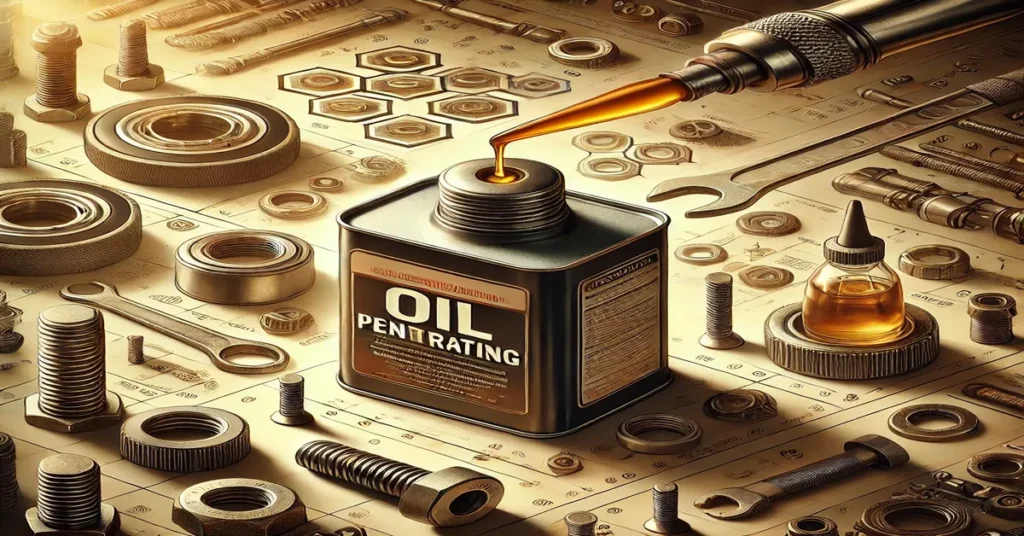Penetrating oil is a versatile and powerful solution widely used in industrial, automotive, and household applications. Known for its ability to seep into tight spaces, dissolve rust, and lubricate moving parts, penetrating oil is an essential tool in any maintenance toolkit. Whether you’re loosening a rusty bolt, reducing friction in machinery, or simply aiming to prevent rust buildup, penetrating oil offers numerous benefits for both professionals and DIY enthusiasts.
In this comprehensive guide, we’ll cover what penetrating oil is, its types, uses, benefits, and how to apply it correctly. We’ll also explore how penetrating oil differs from other lubricants, the factors to consider when choosing one, and some practical tips for safe and effective use.
What is Penetrating Oil?
Penetrating oil is a low-viscosity lubricant designed to infiltrate tight spaces, dissolve rust, and loosen seized or corroded metal parts. Its low viscosity allows it to penetrate narrow gaps, which is essential for loosening bolts, screws, hinges, and other metal components that have become stuck due to rust or corrosion.
Unlike thicker oils, penetrating oil is not meant for long-term lubrication. Instead, it’s primarily used as a temporary fix to free up stuck parts, making them easier to work with or disassemble. Penetrating oils are available in various formulations, including natural and synthetic options, and can be found in both spray and liquid form.
Types of Penetrating Oil
There are several types of penetrating oils, each with unique characteristics that make them suitable for different applications. Here’s a look at the main types:
1. Water-Displacing Penetrating Oils
Water-displacing penetrating oils, such as WD-40, are among the most popular types of penetrating oils. They are specially formulated to displace moisture, preventing rust and corrosion on metal surfaces. Water-displacing oils are ideal for applications in damp or wet environments where rust protection is necessary.
2. Synthetic Penetrating Oils
Synthetic penetrating oils are made from engineered chemicals and are often designed to provide superior performance in terms of penetration and lubrication. They typically offer better resistance to extreme temperatures and high pressures, making them suitable for industrial and automotive applications. Synthetic oils are also less likely to evaporate or degrade over time, providing a longer-lasting effect.
3. Biodegradable Penetrating Oils
Biodegradable penetrating oils are environmentally friendly alternatives to traditional oils. They are made from natural ingredients like vegetable oil or ester-based compounds. Biodegradable oils are often used in environmentally sensitive areas where traditional oils could contaminate soil or water. These oils are generally safe for use on equipment that comes into contact with plants or animals.
4. Evaporative Penetrating Oils
Evaporative penetrating oils are designed to evaporate after application, leaving behind minimal residue. They are often used in applications where a clean finish is essential, such as electronics or delicate mechanical parts. Because they evaporate quickly, these oils are ideal for applications where a lasting residue might attract dirt or debris.
Each type of penetrating oil has specific advantages, so choosing the right one depends on your needs and the nature of the task.
How Does Penetrating Oil Work?
Penetrating oil works by reducing the surface tension between metal parts, allowing the oil to seep into small spaces. Once applied, the oil spreads across the surface and infiltrates even the tightest of crevices. Here’s how it works step-by-step:
- Penetration: The low viscosity of penetrating oil allows it to flow easily into small gaps between metal parts, even if they are corroded or rusted together.
- Lubrication: Once it seeps into the crevices, the oil acts as a temporary lubricant, reducing friction between parts and allowing them to move more freely.
- Rust Dissolution: Many penetrating oils contain solvents or chemicals that dissolve rust and corrosion. This helps break down the bond formed by rust, making it easier to separate parts.
- Protection: Some penetrating oils leave a thin protective layer on metal surfaces, helping prevent future rust and corrosion.
This combination of penetration, lubrication, and rust dissolution makes penetrating oil an effective solution for loosening stuck or seized parts.
Common Uses of Penetrating Oil
Penetrating oil is a versatile tool with a wide range of applications. Here are some of the most common uses:
1. Loosening Rusty Bolts and Screws
One of the most popular uses for penetrating oil’s is loosening rusty or seized bolts and screws. When metal fasteners are exposed to moisture, they can rust and bond together, making them difficult to remove. Penetrating oil’s can infiltrate the rust and dissolve it, allowing you to remove the fasteners with less effort.
2. Preventing Rust and Corrosion
By forming a protective layer on metal surfaces, penetrating oil can help prevent rust and corrosion. This is particularly useful in areas exposed to moisture, such as outdoor equipment, tools, and machinery. Regular application of penetrating oil’s can help prolong the life of these items.
3. Lubricating Hinges and Moving Parts
Penetrating oil is often used to lubricate hinges, gears, and other moving parts. While it’s not meant for long-term lubrication, it can temporarily reduce friction, making it easier to operate doors, locks, and equipment.
4. Maintaining Automotive Parts
In the automotive industry, penetrating oil is used to maintain parts like spark plugs, lug nuts, and exhaust bolts. It helps prevent rust and corrosion in high-moisture environments and makes it easier to disassemble parts for repairs or replacement.
5. Restoring Old Tools and Equipment
If you have old, rusty tools or equipment, applying penetrating oil can help restore them to working condition. The oil breaks down rust and lubricates moving parts, making it easier to use or restore vintage tools.
6. Cleaning and Protecting Electrical Components
Evaporative penetrating oils are often used to clean and protect electrical components by displacing moisture. However, be cautious when using penetrating oil’s on electronics, as not all oils are suitable for these applications.
Penetrating oil is a handy solution for a variety of maintenance tasks, making it an essential product for both DIY enthusiasts and professionals.
Benefits of Using Penetrating Oil
The benefits of using penetrating oil extend beyond just loosening stuck parts. Here’s a look at some of its key advantages:
1. Time-Saving
Penetrating oil’s can save significant time and effort when dealing with rusted or seized parts. Instead of struggling to loosen bolts or screws, a quick application of penetrating oil’s can make the task much easier.
2. Prevents Damage
Trying to forcefully remove rusted bolts and screws without lubrication can lead to stripped threads or broken parts. Penetrating oil reduces the risk of damage by allowing for smoother disassembly.
3. Cost-Effective
Penetrating oil is an inexpensive way to maintain tools, machinery, and equipment. Regular use can extend the life of these items, reducing the need for costly replacements or repairs.
4. Versatile Applications
From household repairs to industrial maintenance, penetrating oil has a wide range of applications. Its versatility makes it a valuable tool for anyone working with metal parts.
5. Improves Equipment Longevity
Regular use of penetrating oil can prevent rust and corrosion, prolonging the life of tools, machinery, and equipment. This is especially important for items exposed to moisture or harsh conditions.
Whether you’re a professional mechanic or a weekend DIYer, penetrating oil’s offers multiple benefits that make maintenance tasks easier and more efficient.
How to Apply Penetrating Oil
Applying penetrating oil’s is relatively simple, but following the correct steps ensures maximum effectiveness. Here’s a step-by-step guide:
- Clean the Surface: Wipe away any dirt or debris from the area where you’ll be applying the oil. This allows the oil to penetrate more effectively.
- Apply the Oil: Shake the can or bottle if necessary. Spray or pour a small amount of penetrating oil directly onto the rusted or seized part.
- Let It Soak: Allow the oil to sit for a few minutes to an hour, depending on the severity of the rust or corrosion. This gives the oil time to penetrate and dissolve the rust.
- Try Loosening the Part: After allowing the oil to soak, use a wrench or screwdriver to try loosening the part. If it doesn’t budge, apply more oil and wait a little longer.
- Repeat if Necessary: For heavily rusted parts, you may need to repeat the application process multiple times to achieve the desired result.
- Wipe Away Excess Oil: After the part has been loosened, wipe away any excess oil to prevent dirt buildup.
Using penetrating oil properly can help you achieve the best results and make maintenance tasks easier.
Choosing the Right Penetrating Oil
There are many penetrating oil’s available on the market, so choosing the right one can be challenging. Here are some factors to consider:
- Application Needs: Consider the specific task you need the oil for. Some oils are better for rust prevention, while others are designed for loosening parts or evaporating quickly.
- Formulation: Decide whether you want a synthetic, water-displacing, or biodegradable oil. Each formulation has different properties and advantages.
- Temperature Resistance: If you’re using penetrating oil’s in high-temperature applications, choose one with high-temperature resistance to prevent it from evaporating or breaking down.
- Environmental Impact: For environmentally sensitive areas, opt for biodegradable or non-toxic penetrating oil’s.
- Brand Reputation: Choose a reputable brand with positive reviews and a proven track record of quality products.
By selecting the right penetrating oil, you can ensure optimal performance for your specific application.
Conclusion
Penetrating oil is a valuable tool with numerous applications, from loosening rusty bolts to protecting metal surfaces from corrosion. Its low viscosity, powerful penetration, and versatility make it an essential product for maintenance, repair, and restoration tasks. Understanding the different types of penetrating oil’s, how they work, and how to apply them correctly can help you make the most out of this versatile lubricant.
Whether you’re a DIY enthusiast looking to restore old tools or a professional mechanic working with automotive parts, penetrating oil’s can make your job easier and more efficient. By following the guidelines provided in this article, you’ll be well-equipped to use penetrating oil’s effectively and achieve the best possible results.
FAQs
1. Can penetrating oil be used on electronics?
Yes, some evaporative penetrating oils are safe for electronics as they displace moisture without leaving residue. However, always check the product label to confirm compatibility.
2. How long should I let penetrating oil sit?
Letting it sit for 10-15 minutes is usually sufficient, but heavily rusted parts may require up to an hour or multiple applications.
3. Can I use penetrating oil as a long-term lubricant?
No, penetrating oil is designed for temporary lubrication. For long-term use, opt for a thicker lubricant like grease.
4. Are all penetrating oils flammable?
Many penetrating oils are flammable due to their chemical composition. Use them in well-ventilated areas and avoid open flames.
5. How do I remove excess penetrating oil?
Wipe away excess oil with a clean cloth to prevent dirt and grime buildup, especially in moving parts or machinery.
6. Is WD-40 a penetrating oil?
Yes, WD-40 is a water-displacing penetrating oil commonly used for loosening rusted parts and preventing moisture buildup.







